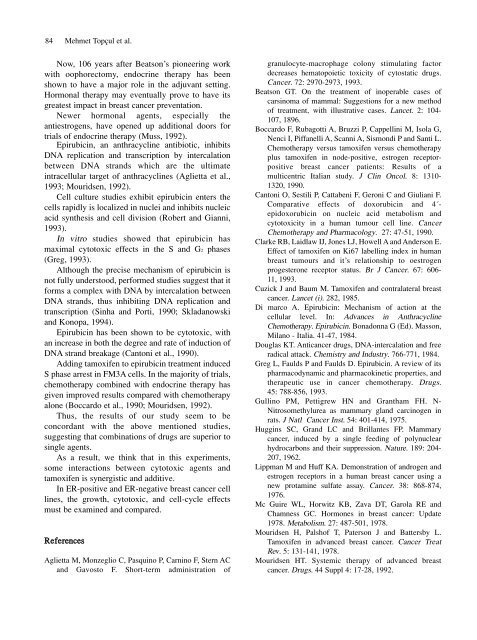Full Journal - Journal of Cell and Molecular Biology - Haliç Üniversitesi
Full Journal - Journal of Cell and Molecular Biology - Haliç Üniversitesi
Full Journal - Journal of Cell and Molecular Biology - Haliç Üniversitesi
You also want an ePaper? Increase the reach of your titles
YUMPU automatically turns print PDFs into web optimized ePapers that Google loves.
84 Mehmet Topçul et al.<br />
Now, 106 years after Beatson’s pioneering work<br />
with oophorectomy, endocrine therapy has been<br />
shown to have a major role in the adjuvant setting.<br />
Hormonal therapy may eventually prove to have its<br />
greatest impact in breast cancer preventation.<br />
Newer hormonal agents, especially the<br />
antiestrogens, have opened up additional doors for<br />
trials <strong>of</strong> endocrine therapy (Muss, 1992).<br />
Epirubicin, an anthracycline antibiotic, inhibits<br />
DNA replication <strong>and</strong> transcription by intercalation<br />
between DNA str<strong>and</strong>s which are the ultimate<br />
intracellular target <strong>of</strong> anthracyclines (Aglietta et al.,<br />
1993; Mouridsen, 1992).<br />
<strong>Cell</strong> culture studies exhibit epirubicin enters the<br />
cells rapidly is localized in nuclei <strong>and</strong> inhibits nucleic<br />
acid synthesis <strong>and</strong> cell division (Robert <strong>and</strong> Gianni,<br />
1993).<br />
In vitro studies showed that epirubicin has<br />
maximal cytotoxic effects in the S <strong>and</strong> G2 phases<br />
(Greg, 1993).<br />
Although the precise mechanism <strong>of</strong> epirubicin is<br />
not fully understood, performed studies suggest that it<br />
forms a complex with DNA by intercalation between<br />
DNA str<strong>and</strong>s, thus inhibiting DNA replication <strong>and</strong><br />
transcription (Sinha <strong>and</strong> Porti, 1990; Skladanowski<br />
<strong>and</strong> Konopa, 1994).<br />
Epirubicin has been shown to be cytotoxic, with<br />
an increase in both the degree <strong>and</strong> rate <strong>of</strong> induction <strong>of</strong><br />
DNA str<strong>and</strong> breakage (Cantoni et al., 1990).<br />
Adding tamoxifen to epirubicin treatment induced<br />
S phase arrest in FM3A cells. In the majority <strong>of</strong> trials,<br />
chemotherapy combined with endocrine therapy has<br />
given improved results compared with chemotherapy<br />
alone (Boccardo et al., 1990; Mouridsen, 1992).<br />
Thus, the results <strong>of</strong> our study seem to be<br />
concordant with the above mentioned studies,<br />
suggesting that combinations <strong>of</strong> drugs are superior to<br />
single agents.<br />
As a result, we think that in this experiments,<br />
some interactions between cytotoxic agents <strong>and</strong><br />
tamoxifen is synergistic <strong>and</strong> additive.<br />
In ER-positive <strong>and</strong> ER-negative breast cancer cell<br />
lines, the growth, cytotoxic, <strong>and</strong> cell-cycle effects<br />
must be examined <strong>and</strong> compared.<br />
References<br />
Aglietta M, Monzeglio C, Pasquino P, Carnino F, Stern AC<br />
<strong>and</strong> Gavosto F. Short-term administration <strong>of</strong><br />
granulocyte-macrophage colony stimulating factor<br />
decreases hematopoietic toxicity <strong>of</strong> cytostatic drugs.<br />
Cancer. 72: 2970-2973, 1993.<br />
Beatson GT. On the treatment <strong>of</strong> inoperable cases <strong>of</strong><br />
carsinoma <strong>of</strong> mammal: Suggestions for a new method<br />
<strong>of</strong> treatment, with illustrative cases. Lancet. 2: 104-<br />
107, 1896.<br />
Boccardo F, Rubagotti A, Bruzzi P, Cappellini M, Isola G,<br />
Nenci I, Piffanelli A, Scanni A, Sismondi P <strong>and</strong> Santi L.<br />
Chemotherapy versus tamoxifen versus chemotherapy<br />
plus tamoxifen in node-positive, estrogen receptorpositive<br />
breast cancer patients: Results <strong>of</strong> a<br />
multicentric Italian study. J Clin Oncol. 8: 1310-<br />
1320, 1990.<br />
Cantoni O, Sestili P, Cattabeni F, Geroni C <strong>and</strong> Giuliani F.<br />
Comparative effects <strong>of</strong> doxorubicin <strong>and</strong> 4´epidoxorubicin<br />
on nucleic acid metabolism <strong>and</strong><br />
cytotoxicity in a human tumour cell line. Cancer<br />
Chemotherapy <strong>and</strong> Pharmacology. 27: 47-51, 1990.<br />
Clarke RB, Laidlaw IJ, Jones LJ, Howell A <strong>and</strong> Anderson E.<br />
Effect <strong>of</strong> tamoxifen on Ki67 labelling index in human<br />
breast tumours <strong>and</strong> it’s relationship to oestrogen<br />
progesterone receptor status. Br J Cancer. 67: 606-<br />
11, 1993.<br />
Cuzick J <strong>and</strong> Baum M. Tamoxifen <strong>and</strong> contralateral breast<br />
cancer. Lancet (i). 282, 1985.<br />
Di marco A. Epirubicin: Mechanism <strong>of</strong> action at the<br />
cellular level. In: Advances in Anthracycline<br />
Chemotherapy. Epirubicin. Bonadonna G (Ed). Masson,<br />
Milano - Italia. 41-47, 1984.<br />
Douglas KT. Anticancer drugs, DNA-intercalation <strong>and</strong> free<br />
radical attack. Chemistry <strong>and</strong> Industry. 766-771, 1984.<br />
Greg L, Faulds P <strong>and</strong> Faulds D. Epirubicin. A review <strong>of</strong> its<br />
pharmacodynamic <strong>and</strong> pharmacokinetic properties, <strong>and</strong><br />
therapeutic use in cancer chemotherapy. Drugs.<br />
45: 788-856, 1993.<br />
Gullino PM, Pettigrew HN <strong>and</strong> Grantham FH. N-<br />
Nitrosomethylurea as mammary gl<strong>and</strong> carcinogen in<br />
rats. J Natl Cancer Inst. 54: 401-414, 1975.<br />
Huggins SC, Gr<strong>and</strong> LC <strong>and</strong> Brillantes FP. Mammary<br />
cancer, induced by a single feeding <strong>of</strong> polynuclear<br />
hydrocarbons <strong>and</strong> their suppression. Nature. 189: 204-<br />
207, 1962.<br />
Lippman M <strong>and</strong> Huff KA. Demonstration <strong>of</strong> <strong>and</strong>rogen <strong>and</strong><br />
estrogen receptors in a human breast cancer using a<br />
new protamine sulfate assay. Cancer. 38: 868-874,<br />
1976.<br />
Mc Guire WL, Horwitz KB, Zava DT, Garola RE <strong>and</strong><br />
Chamness GC. Hormones in breast cancer: Update<br />
1978. Metabolism. 27: 487-501, 1978.<br />
Mouridsen H, Palsh<strong>of</strong> T, Paterson J <strong>and</strong> Battersby L.<br />
Tamoxifen in advanced breast cancer. Cancer Treat<br />
Rev. 5: 131-141, 1978.<br />
Mouridsen HT. Systemic therapy <strong>of</strong> advanced breast<br />
cancer. Drugs. 44 Suppl 4: 17-28, 1992.

















